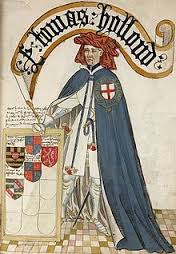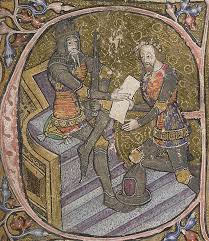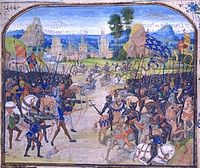
Last week we left Geoffroi de Charny about to join battle with the English near Poitiers. It was Monday, 19th September 1356. An army led by the king of France, Jean II, had been pursuing an English, Welsh and Gascon army led by Edward of Woodstock (better known now as the Black Prince) for some days.
For most of his career, de Charny had the good fortune not to be in the wrong place at the wrong time. He wasn’t, for example, at the battle of Crécy, where so many French knights and nobles were killed or taken prisoner that Philippe VI couldn’t raise an army large enough to take on Edward III at the siege of Calais a few months later. De Charny gained his reputation in siege warfare, but he was probably disappointed not to have faced the English in battle. His chance had finally come.
That morning it looked as if he still might be denied the opportunity of fighting in a battle. The prevailing opinion in the French camp was that the English army was in no state to fight and would retreat at the first opportunity, which was probably what Edward of Woodstock intended. He was at the end of a summer’s campaign of raiding in south-west France. As with many campaigns in the Hundred Years War, the objective was to show that the king of France was unable to protect his subjects, the main duty of a medieval king, and to take some booty along the way. After two years of such raids, it was a point so well made that the king had to do something.
Jean II was able to put together an impressive army made up of knights of the Order of the Star, men from the duchies and kingdoms on the eastern borders of France who owed allegiance to the French king, a large Scottish retinue and some mercenaries. They were all well-rested and well-supplied. Their main difficulty had been finding the enemy in order to engage them.
Edward of Woodstock had been leading his men in raids for two summers. It was a relatively small army and their supplies were exhausted. There had been almost nothing to eat or drink on the day before the battle. They had been avoiding the larger French army for some days and were very tired. Although they had picked a good spot for the battle and had reinforced it, the plan was still to slip away before battle could be joined.
De Charny was entrusted with the Oriflamme, the French king’s battle standard. It was a huge honour and it had been put into his hands during a religious ceremony at the abbey of St. Denis. When it was carried into a battle it was a sign that no prisoners would be taken. This was meant to scare the opposition into surrender, as most nobles didn’t expect to die in battle, but to be taken prisoner for ransom, as had happened to de Charny himself, twice. On this day, however, he could look forward to the knights of France demonstrating all the aspects of chivalry that he had written about and defeating the English.
There really could be little doubt about the outcome. The English army was about 6, 000 men strong. The French army was twice the size. The scene was set for a great French victory, except …
Except Jean II was no strategist. He was a man of great personal bravery, but he didn’t really know what to do with an army. Despite all his advantages going into this particular battle, he wasn’t a leader of men. Even had his opponent not been the greatest soldier of his time, Jean II would have struggled.
Except he French knights had not learned what de Charny had tried to teach them. Personal glory was still their main motivation and they couldn’t work together under the king or even obey him. The English and the Gascons, on the other hand, had been fighting together as a unit for months, under a commander who knew what he was doing.
Except no one had worked out a proper strategy for dealing with the English and Welsh archers. They had played an important role in defeating the French at the battle of Crécy and 10 years later the French still had no plan for opposing them. The only thing they had really thought about and prepared for (at the last minute) was the English preference for fighting on foot, which they had learned from the Scots.
In the end, the English didn’t run away, but fought. All day de Charny was in the thick of the battle holding up the king’s standard. We can’t know if he saw or understood much of what was going on around him, but he probably died, the battle standard still in his hands, before Jean II was captured by the English. He certainly didn’t live to know that more than eighty members of the Order of the Star had been killed or that more than a quarter of the army had been taken prisoner. Over two and a half thousand men from the French army died. The day that should have demonstrated the renewal of French chivalry ended in its complete defeat.
Sources:
Trial by Fire by Jonathan Sumption
The Book of Chivalry by Geoffroi de Charny by Richard W. Kaeuper and Elspeth Kennedy
April Munday is the author of the Soldiers of Fortune and Regency Spies series of novels, as well as standalone novels set in the fourteenth century.
Available now:









